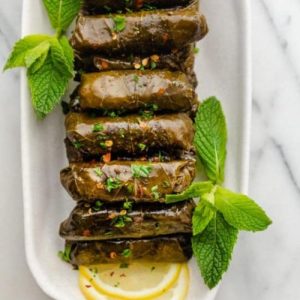
Lebanese Stuffed Grape Leaves
Delight in these Lebanese Stuffed Grape Leaves, filled with a savory beef and rice mixture, seasoned with aromatic spices, and gently cooked to perfection. High in protein and fiber, they’re a nutritious, flavorful, and versatile dish ideal for appetizers, main courses, or meal prep.
Equipment
- 1 large mixing bowl
- 1 large nonstick skillet or sauté pan
- 1 large pot with lid
- 1 Cutting board
- 1 Chef’s knife
- 1 Chef’s knife
- 1 plate (for holding rolled grape leaves)
Ingredients
- 2 tbsp olive oil plus extra for drizzling
- 1 lb ground beef
- ½ tsp salt plus more for seasoning
- 2 tsp 7-Spice mix
- 1 ½ cups short-grain white rice
- ¼ tsp cinnamon
- 1 jar grape leaves approx. 60–70, in brine
- 2 Yukon Gold potatoes sliced
- ¼ cup fresh lemon juice
- Salt and pepper to taste
- Optional: sliced tomatoes for layering
Instructions
- Preparing the Grape Leaves: Begin by draining the grape leaves from their brine.Place them in a large bowl of cool water to remove excess salt and brine flavor. Gently separate each leaf, being careful not to tear them, and wash them thoroughly. Lay the leaves flat on a clean plate in a single layer. Cover them with a damp cloth to keep them soft and pliable while you prepare the stuffing. This step ensures your leaves are tender and easy to roll.
- Cooking the Meat Base: Heat 2 tablespoons of olive oil in a large skillet over medium heat. Add the ground beef and cook, stirring occasionally, until it turns golden brown and any liquid is evaporated. Season the meat with ½ teaspoon of salt and 2 teaspoons of 7-Spice. Continue to cook for 2–3 minutes to allow the spices to bloom, creating a rich and aromatic base for your stuffing.
- Incorporating Rice and Spices: Once the beef is fully browned, add 1 ½ cups of uncooked short-grain rice directly into the skillet. Sprinkle ¼ teaspoon of cinnamon over the mixture. Stir thoroughly to combine the rice and meat, ensuring each grain is coated with the flavorful spices and olive oil. The uncooked rice will absorb the flavors and cook inside the grape leaves, creating a tender, aromatic filling.
- Preparing the Pot for Layering: Before rolling the grape leaves, prepare a large pot for cooking. Line the bottom with thinly sliced Yukon Gold potatoes or optional tomato slices. Sprinkle a pinch of salt and pepper over the potatoes to season. This layer prevents the grape leaves from sticking to the bottom and adds additional flavor to the dish.
- Rolling the Grape Leaves: Take one grape leaf and lay it flat on a cutting board with the veined side facing up. Place a heaping teaspoon of the beef and rice mixture in the center of the leaf. Fold the sides inward, then roll the leaf tightly from the stem end to the tip, forming a neat cylinder. Repeat this process with all remaining leaves, making sure each roll is compact but not overstuffed. Neatly arrange the rolls in the prepared pot, alternating directions with each layer to create a snug, even packing.
- Drizzling and Layer Seasoning: After placing each layer of stuffed grape leaves, drizzle lightly with olive oil and sprinkle with a pinch of salt and pepper.This step ensures each layer has enough moisture and flavor to cook evenly. Continue layering and seasoning until all grape leaves are packed into the pot.
- Securing the Rolls: To prevent the rolls from floating while cooking, place a small, heat-safe plate on top of the grape leaves inside the pot. This will hold them down and help maintain their shape during simmering, resulting in evenly cooked, tender grape leaves.
- Adding Water and Initial Cooking: Pour 5–6 cups of boiling water into the pot, enough to fully cover the grape leaves and the plate. Cover the pot with a lid and bring to a gentle simmer over medium heat. Cook for approximately 30 minutes, or until most of the water is absorbed and the rice inside the rolls is tender but not mushy.
- Adding Lemon Juice and Final Simmer: Once the initial cooking is complete, pour ¼ cup of fresh lemon juice evenly over the grape leaves. Reduce the heat to low, cover the pot, and continue to cook for an additional 45 minutes. The lemon juice infuses a bright, zesty flavor and helps tenderize the leaves further, balancing the rich meat and rice filling.
- Cooling and Serving: After cooking, remove the pot from heat and let it sit uncovered for 30 minutes. This allows the flavors to settle and the rolls to firm slightly for perfect slicing. Carefully transfer the grape leaves to a serving dish. Serve warm as an appetizer, side dish, or main course, garnished with extra lemon slices if desired.
Notes
- Use short-grain white rice for the best texture; long-grain rice may not absorb flavors as well.
- Grape leaves should be soaked and rinsed to remove excess brine and prevent saltiness.
- Rolling technique is key: fold sides before rolling tightly to keep the stuffing intact during cooking.
- Layering potatoes or tomatoes at the bottom prevents sticking and adds subtle flavor.
- Lemon juice at the end brightens the dish and balances richness.
- You can make the meat and rice stuffing (hashweh) 1–2 days in advance for convenience.
- Adjust the 7-Spice seasoning according to taste; it can be replaced with a mix of allspice, cinnamon, and nutmeg if unavailable.
- Ground lamb can be used instead of beef for a more traditional flavor.